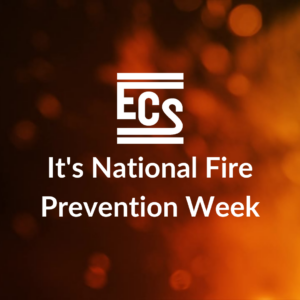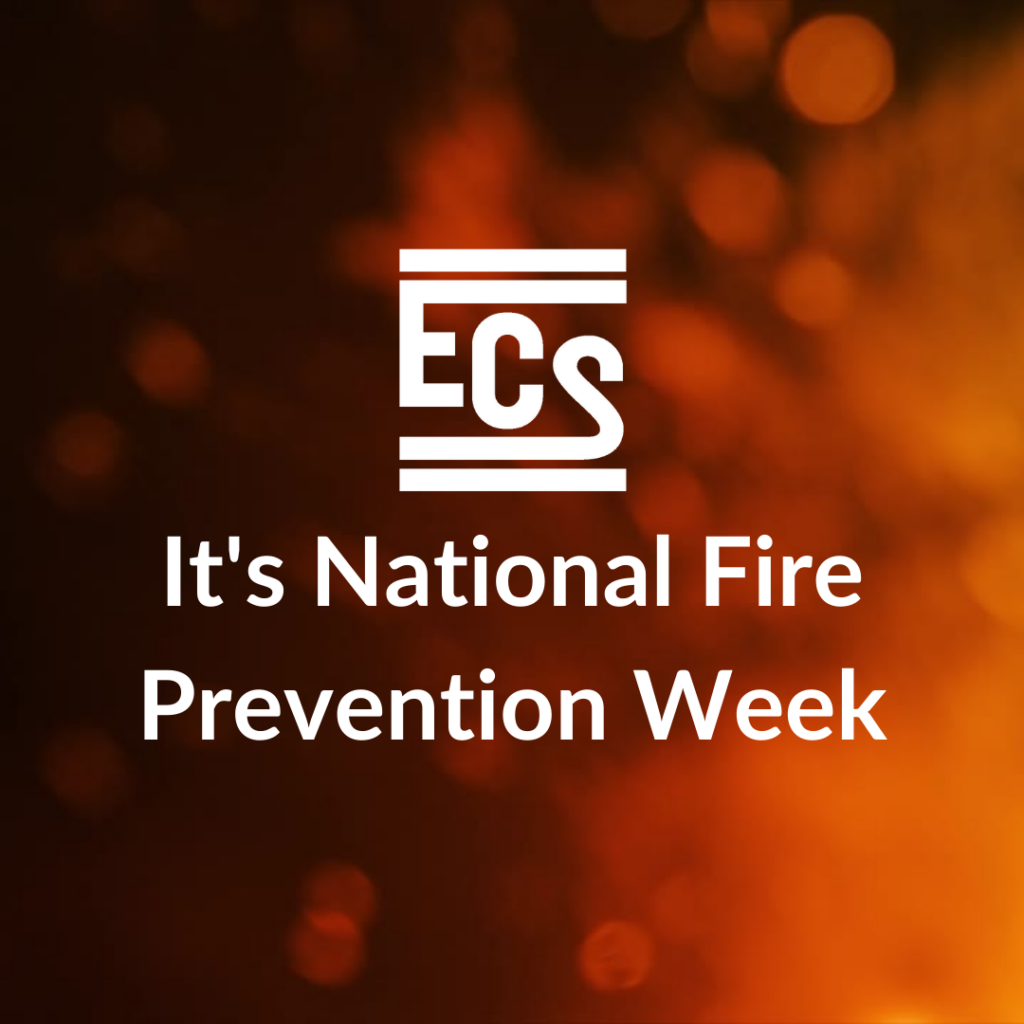
Did you know Fire Prevention Week is the longest standing public health observance in the United States? Since 1925, when President Calvin Coolidge made this proclamation, firefighters across the country have provided lifesaving education to adults and children.
Fire prevention and safety takes many forms. While ECS may not be fighting fires, we offer many services to help with fire prevention in the design of a structure. Our facilities team has many highly experienced professionals that have a large knowledge base in fire prevention and safety codes as well as many other aspects that play into the integrity and safety of the structure.
In the spirit of fire prevention week, we interviewed ECS’ Shea Johnson and Denis Columbare Jr. to provide our clients with valuable advice about fire safety, codes and suppression.
Shea is a Code Compliance Senior Project Manager with the Southeast Facilities team who recently joined ECS. Shea brings more than 22 years of experience in fire protection.
Denis of our Pittsburgh office is in the process of expanding our fire prevention and safety systems testing capabilities. Denis’ lab will be able to pressure test clients existing fire suppression systems and systems that are going into new construction which will help with determining the functionality of their systems. In the future there will be the ability to test the self-extinguishing properties of fire-retardant materials and coatings.
Q: What are fire and life safety standards and why are they important?
A: The objective of fire prevention and life safety standards is to provide a reasonable degree of life safety to allow first responders the ability to anticipate and respond to the dynamic public safety needs of a community. It is to protect life first and then property. The term “fire prevention” by itself allows for many things to automatically be overlooked. Much like firefighters are first and primarily known to fight fire, many fire departments are considered all threat response. They respond to not only fires, but medical emergencies, vehicular accident, floods, earthquakes, hurricanes, building collapse, train derailments, hazardous materials spills, etc. Fire prevention and more specifically life safety must be looked at as a community’s risk reduction. How do we allow first responders to perform their job in the safest and most efficient way possible? We start with getting them from their point of origin to the location of service as quickly and safely as possible. We then utilize our built infrastructure of buildings and systems to increase fire and life safety time, we allow first responders to safely perform their functions. Fire prevention must consider all aspects, from original design, construction, and demolition activities, from how first responders will gain access along roadways, to the interior of a building and how those environments will impact life safety and property protection.
Q: How often do fire codes change?
A: Model codes, such as those published by the National Fire Protection Association (NFPA) and the International Code Council (ICC) are published on a tri-annual basis. In most states and local jurisdictions around the country, a model code will be adopted and/or modified into a state code or local municipal code or ordinance. It is common to see states or local jurisdictions be one full code cycle behind the current model code. In addition to the model code, there are many referenced standards that are modified and adopted as referenced in the model codes.
Q: When a change in these codes occurs, who is affected?
A: Changes in model codes related to fire prevention/life safety affect everyone from an architect, engineer, contractor, developer, building owner, building tenant, local government, utility providers and ultimately even the end user of the building or property. Changes are often driven by industry, with new means or methods to provide for safety. These industry-driven changes can often impact market shares of construction materials and components, such as piping, gypsum, concrete, steel, wood, and other building components. Changes may allow for different means of construction that allow a project to be completed faster and less expensive while still providing for the minimum fire and life safety requirements. Changes in these codes, while infrequent, may be retroactive based upon large loss fires or other disasters. This can impact building owners as these changes are frequently unfunded mandates. Changes to codes can often be because of new industries, such as photovoltaic systems and large battery storage systems. These changes can impact how local government and first responders develop tactics and evaluate hazards.
Q: Are these codes difficult to understand and how do we help our clients navigate them properly?
A: Fire and life safety codes can be both easy to understand and very complex depending on what is being evaluated. ECS subject matter experts can assess changing requirements from model codes and local jurisdictions. Our suite of capabilities includes:
- Developing strategies for compliance on overlooked items.
- Developing performance-based solutions to challenging design concepts and working with local authorities having jurisdiction to obtain approvals for alternative means or methods
- Providing third-party peer review on design documents to help facilitate the design, bid process, and ultimately the installation of fire and life safety features.
- Providing qualified code interpretations and working with authorities having jurisdiction to find acceptable levels of fire and life safety requirements where there is no consensus on code requirements.
- Collaborating with current building owners to develop cost-effective strategies to meet and maintain code compliance.
- Performing quality control/quality assurance inspections of ongoing construction.
- Providing maintenance inspection of passive and active fire protection systems to help building owners and property management companies maintain compliance.
- Performing qualified third-party inspections for State, County, City, etc. building and fire code officials.
- Assisting in the code development and code adoption process.
Q: Denis, how do your lab capabilities provide additional benefit?
A: In addition to benefiting product manufacturer clients from a quality assurance standpoint as to if their product was manufactured correctly and does what it is supposed to do, on the flip side it would benefit contractors as well as building owners to assure that their new or currently installed fire suppression systems are operating correctly and were installed correctly.
Q: What aspects of fire and life safety are most overlooked?
A: The most overlooked portion of fire and life safety for the construction environment is initial design. Many local jurisdictions make changes to codes and adopted standards, if these changes are not known by architects, engineers, and contractors, they can create major delays in plan review and the construction process, potentially costing tens of thousands of dollars in lost time and additional work. Additionally, many fire prevention features are deferred design and or design build system. This often results in a lack of coordination amongst trades and allows for inadequate design or over design of required systems. Fire prevention professionals can help to coordinate these systems and make sure that the buildings meet the requirements of the code and the needs of the development.
The most common overlooked aspects of fire prevention in the built environment are related to maintenance of systems. Maintain your built environment. Perform required inspection, testing and maintenance of buildings fire sprinkler and fire alarm system. Maintain your cooking appliances and clean your cooking ventilation systems, cooking appliances are the number one cause of commercial fires in the United States. Maintain your active fire protection features such as smoke control, fire and smoke dampers, and stair pressurization. Maintain your passive fire protection features such as fire doors, walls, and barriers.
Our facilities team is dedicated to making sure our clients are compliant with fire codes and that their projects maintain safety standards throughout the lifecycle of the building. Get in contact with our exceptional facilities team today to see how they can help with projects like this and so much more!

